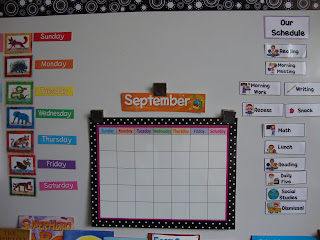This week we began our unit on addition. I am trying to be very explicit in my teaching of math vocabulary this year. So, for this chapter, our math words were: part and whole. I had these words on our pocket chart and briefly introduced them to the class as the words for the week.
Then, I showed the students my apple. I explained that I had a whole apple. Then, in front of the class, I cut the apple and asked what I had. Some said, a half, a piece. Finally, one little girl said, "A part." She must have realized that I was trying to get the class to think about our math words. Smiling, I said, "Yes, I had a part." We talked about if I put the two parts together I make a whole. The kids repeated this line: I put two parts together to make a whole. Using this same analogy, I then, showed them the workmat they would be using.
It was amazing how well they understood the concept of adding two parts to make a whole.
Some of the things I do to help keep order in lessons like these is to tell them we always start with the red side of the counters. Then, we use yellow. I even had them color the left side red and the right side yellow on their workbook page to help them remember. Luckily, by the second day most students were using the red side of the counter first.
Little things like this, help them to see the pattern as we begin to how to make 10 or 5.
Some of the things I do to help keep order in lessons like these is to tell them we always start with the red side of the counters. Then, we use yellow. I even had them color the left side red and the right side yellow on their workbook page to help them remember. Luckily, by the second day most students were using the red side of the counter first.
Little things like this, help them to see the pattern as we begin to how to make 10 or 5.
















 I'm Mrs. Parker; a wife, mother and a lifelong learner. I am blessed to be a kindergarten teacher where I get to laugh, learn and play alongside my students. My blog is a reflection of my journey as a teacher.
I'm Mrs. Parker; a wife, mother and a lifelong learner. I am blessed to be a kindergarten teacher where I get to laugh, learn and play alongside my students. My blog is a reflection of my journey as a teacher.



